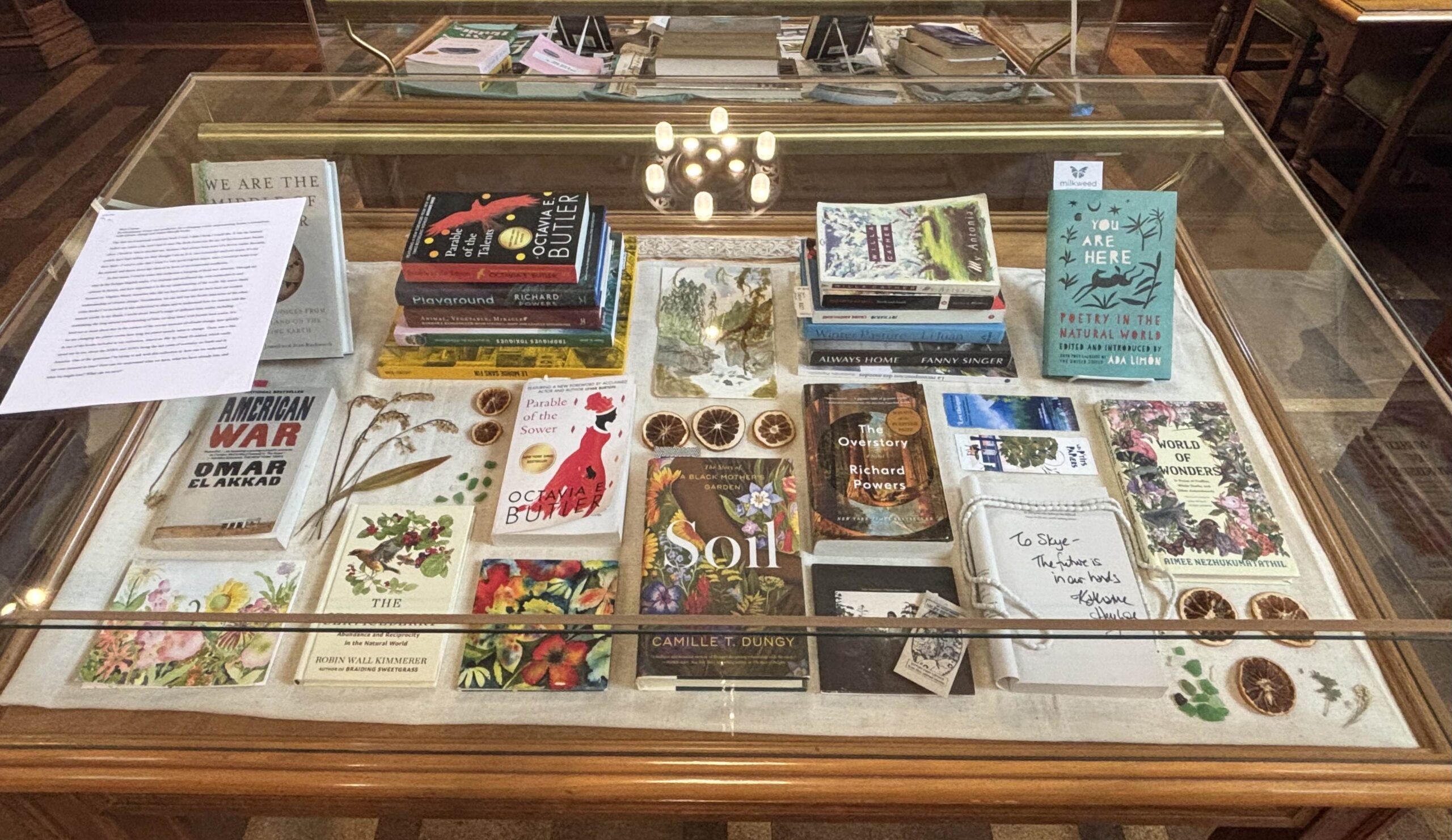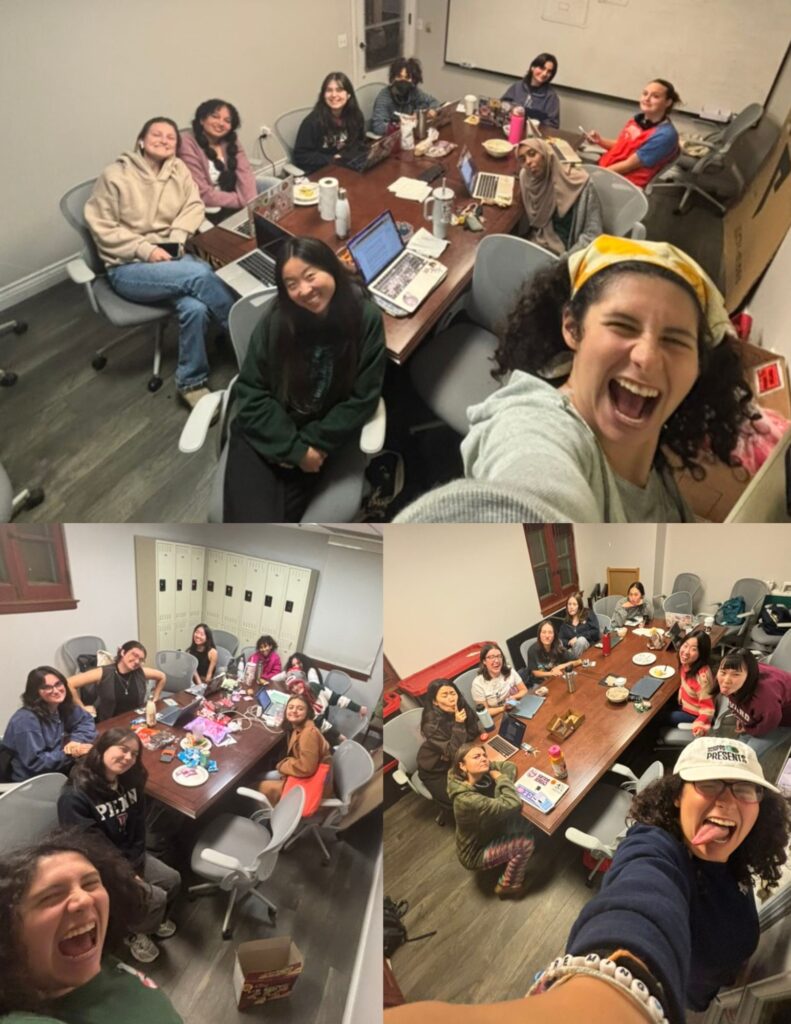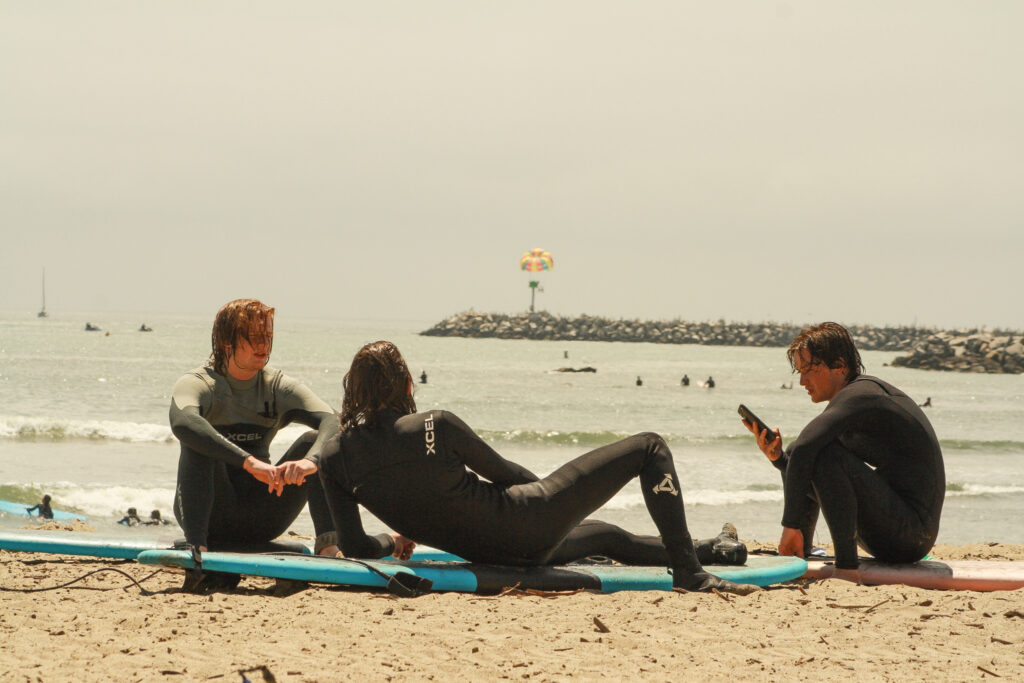Cassidy Miller ’28
Staff Writer
Just past the front entrance of Denison Library, several book collections, accompanied by a printed short essay, lay encased in decorated glass display cases. The displays, created for Denison Library’s annual Slocum Awards competition, featured the personal book collections of several Scripps seniors.
This year’s participants from the Class of 2025 were Skye Curren, Erin Davidson, Mason Maxam, Anya Nyman, Marin Plut, Elle Propp, Corina Silverstein, Wendy Walter, Eliet Williamson-Diaz, Ellen Wang, and Belén Yudess.
Established in 1936, the Slocum Awards provide the opportunity for Scripps seniors to compile and display a personal collection of books that they have formed during their college careers. According to a brochure sent in an email by Denison Library Director, Jennifer Martinez- Wormser, the collections included an annotated bibliography and a short essay that explains the main focus of the collection. The collections were presented to three judges who will determine a winner that will be announced at commencement. Entrants will also be invited to a luncheon with the judges and a trip to the Huntington Library in San Marino for high tea.
Skye Curren ’25, a participant in this year’s competition, explained that her interest in the competition was sparked by her connection to Denison.
“I’ve worked at Denison since I was a [first-year] and so I’ve always known about the Slocum competition ever since [the displays] went up my freshman year. I think because of that, I knew that it was something I wanted to participate in just because I’ve known, through Denison, a lot of people who have participated in it over the years,” she said.
Another entrant, Mason Maxam ’25, said that her initial draw towards the competition was shaped by her interest in book-collecting.
“I as mostly interested in the idea of having a collection of books,” she said. “My whole life, I’ve been really into going to bookstores and collecting books so when I kind of saw that there was a competition that allowed me to showcase my collection, I was really excited.”
Other entrants were drawn to the competition by the opportunity to tour the Huntington Library.
“I’ve been to the Huntington twice, but it’s so cool,” Wendy Walter ’25, another entrant, said. “And the possibility of being able to go behind the scenes was something that really attracted me.”
Alongside the perks of being entered in the competition, the Slocum Awards offer each participating senior a chance to engage with a topic or theme of personal interest.
Curren’s collection focused on fictional and nonfictional environmental literature and includes works such as The Overstory by Richard Powers and Braiding Sweetgrass by Robin Wall Kimmerer.
“I’m an English major, so I had a lot of experience reading fiction in my classes, and I’ve always just loved reading fiction,” Curren said. “But I also have a real interest in environmental issues, and I read a lot of environmental nonfiction in my free time. So I was trying to make this collection, like, sort of a merging of those two interests.”
Although the combination of interests in literature and the environment was a goal of her collection, Curren said that she had already been collecting books related to this theme before entering the competition.
“I wouldn’t say I was collecting books with the purpose of them being in [the Slocum Exhibition], it was more like I was collecting books that I was interested in, and [the collection] ended up having more of a general theme,” Curren said.
Some of the books in Curren’s collection had a deeper personal connection, outside of her general interest in environmental literature.
“Braiding Sweetgrass, I read when I was on a camping trip with my friend that was like three weeks, and we were just in the Pacific Northwest, which I hadn’t really explored that much at that point because I’m from Connecticut,” she said. “Being outside in nature everyday and then, like, going back to my sleeping bag every night and reading that book, that was just a super special time for me.”
The Slocum Exhibition also gives contestants the opportunity to further personalize their collection by decorating their display cases. They can do this by including pieces from other mediums, such as CDs and zines. To connect to the overall theme of her collection, Curren chose to include decorations that evoked natural imagery.
“I had pressed some lily of the valley that I had, and some sea glass that I had when I visited some friends. And I have bookmarks from different bookstores I’ve been to. And I harvested oranges that I got from the Scripps student garden,” Curren said.
The competition’s only significant challenge, according to Curren, was figuring out how to transport her collection to Scripps.
“A lot of my books I had brought, I had at home, or brought home, and I live in Connecticut and so one of my suitcases was just books,” Curren said.
Maxam’s collection was also heavily connected to her own academic interests.
“I focus a lot on political theory and specifically, conservative political theories, so I was kind of interested in building a collection around the same academic interest,” Maxam said.
Maxam’s collection, which included around 28 books, showcased her interest in power dynamics and political theory in American politics.
“My title is called ‘Contested Common Sense’ and it focuses on power conflict and the politics of possibility. And I kind of see it as an intellectual archive of power, specifically how power is structured, justified, contested, and lived through experiences, and it reflects my evolving effort to understand democracy and social order, specifically in the United States,” Maxam said.
Maxam’s book collection was organized into several sections. The first section focuses on the foundations of power, and includes Karl Marx’s Capital, Frederick Hayek’s The Constitution of Liberty, The Reactionary Mind by Corey Robin, and Discipline and Punish by Michel Foucault.
“The second section is more about the American Condition. So this is where I have Saidiya Hartman’s Scenes of Subjection. I also have a book called Dying of Whiteness by Jonathan Metzl, and this book examines how power shapes self-perception and political identity, and even health outcomes,” Maxam said.
The final section of Maxam’s collection focused on world-building, specifically, how humanity can reimagine what the world or its political systems can look like.
This section included Saidiya Hartman’s Wayward Lives, Beautiful Experiments, Sylvia Federici’s Revolution at Point Zero, Robin Wall Kimmerer’s Braiding Sweetgrass, and Women Who Run With the Wolves by Clarissa Pinkola Estés,” she said.
Out of all of the books in her collection, Wayward Lives is the book that Maxam has the strongest personal connection to.
“Something about [Wayward Lives] really stuck with me. I was really interested in the idea of taking historical archives and turning them into living stories where we are writing about these young women in a new light or way that hasn’t really been written before,” Maxam said.
Maxam also commented on the experience of organizing her collection and personalizing her book display.
“I think the most fun and rewarding part for me was taking a look at all of my options and all of the books that I had, and going through and selecting which books would fit into my collection the most,” she said “And so I spent a lot of time lining the books up and putting them in different orders and playing with the different sections.”
Ultimately, for Maxam, the most challenging part of the experience was figuring out how to fit all of her ideas into the short essay.
“I felt like I had so much to say, so I struggled to try to fit [the] goals of my collection into one piece while also sharing my own personal experience in my stories,” Maxam said. Similarly to Curren and Maxam, Walter also wanted to highlight a specific academic interest, with their collection highlighting the history of science and medicine. Although the collection reflects her area of study, Walter said her collection started to take shape well before her college years as a result of her interest in the history of medicine.
“My parents noticed this about me, noticed this was an interest of mine, noticed that I was picking up these books, and I would talk about this sort of thing with them,” Walter said. “And so during holidays and that sort of situation, they would get me books which fit these criteria.”
Walter’s collection includes books such as Paul de Kruif’s Microbe Hunters, and two books from the childrens’ series, Jimmy Microbe.
When speaking about Microbe Hunters, Walter said, “he’s got a very engaging style, and you can see how this inspires a love of medicine, a love of this sort of work of saving lives through epidemiology, through microbiology, through bacteriology, and a very early part of this discipline, when it’s still really developing.”
Walter’s collection also includes books about the history of polio. As part of her display, they included a coin commemorating Jonas Salk, the inventor of the polio vaccine.
While the collection gave Walter the chance to express their academic interest, one difficulty they ran into was how to explain and identify why certain books classify as historical artifacts.
“Some of these aren’t like histories in the conventional sense,” Walter said. “I’m viewing them as historical artifacts. And that’s something that I have to articulate when I’m trying to convey what this collection is and what it means to me.”
For example, Walter mentioned the Jimmy Microbe books as being unique pieces of literature in the history of disease.
“I appreciate a little historical continuity, but I think [the books] are also really fun because I kind of treat those as like they are historical artifacts in their own right,” Walter said. “They’re not about a history of disease, but they are part of that history of disease, because in them, you can see how people [were] thinking about this in the 1930s. How are they trying to convey that information to children, and not just children, to adults who might not know?”
After all the entrants submitted their collections, the contestants met with the judges for a luncheon in the Denison Courtyard where they gave seven-minute presentations on their entries.
“It was really nice to have someone show interest in my own academic pursuits,” Maxam said. “And I thought it was really great and it pushed me to think more about my collection and the things that I’ve learned.”
While the winner will not be announced until commencement, some of the contestants expressed satisfaction with their experience and claimed that their book collections gave them a deeper connection to their academic experiences at Scripps.
“But looking back, I’ve been able to really appreciate it,” Walter said. “I did my thesis last semester, and got a little burnt out. I did do a little bit of work and like, I really enjoy this, looking at these things makes me so excited and makes me so happy.”
All submissions will be available for viewing at Dension until commencement.
Photo Courtesy of Cassidy Miller ’28



